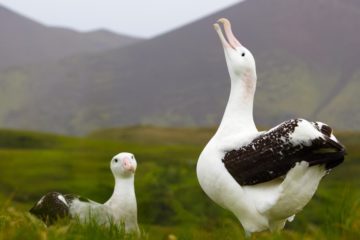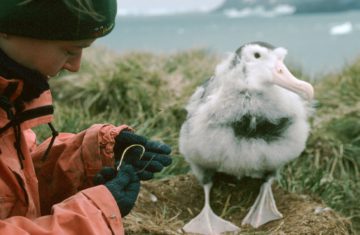Seabirds spend nearly 40% of their time in high seas
Albatrosses and large petrels spend 39% of their time in places where no single country has jurisdiction. The results come from a new global analysis of the year-round movements of the world’s most threatened group of birds and is published in the scientific journal Science Advances this week (3 March 2021).
The researchers from 16 countries tracked the movements of 5,775 individual birds belonging to 39 species using miniature electronic devices. They found that all species regularly cross into the waters of other countries, meaning that no single nation can adequately ensure their conservation. Furthermore, all species depended on the high seas, which are areas of international waters covering half of the world’s oceans and a third of the Earth’s surface.

“Seabirds like albatrosses are the ultimate globetrotters,” says Martin Beal, lead author of the study at the Marine and Environmental Sciences Centre at ISPA – Instituto Universitário in Lisbon, Portugal. “But this incredible lifestyle makes them vulnerable to threats in places where legal protection is inadequate.”
Albatrosses and their close relatives, the large petrels, are among the world’s most-threatened animals, with over half of the species at risk of extinction. While at sea they face a number of threats, including incidental mortality (bycatch) in fishing gear, pollution and loss of their natural prey due to overfishing and climate change.
Co-author Professor Richard Phillips, from British Antarctic Survey, says:
“Albatrosses and large petrels face particular threats from fishing vessels in international waters. There the regulations to reduce seabird bycatch in longline fisheries are weaker than in national waters, and only a very small proportion of vessels have an independent observer on board to monitor compliance with seabird-bycatch mitigation and bycatch rates.”
For example, the Wandering Albatross, which is listed as globally Vulnerable to extinction by the International Union for the Conservation of Nature (IUCN) spends over half its time in international waters of the South Atlantic, Indian and Pacific Oceans. The population breeding at the UK Overseas Territory of South Georgia benefits from good management of the fisheries in the surrounding marine protected area. However, these birds spend much more of their time feeding at sea in international waters during both the breeding and nonbreeding seasons. Their nonbreeding ranges are vast, including most of the oceans south of 30°S, requiring international coordination to minimize the risk of them being killed in fishing gear.

In a global-scale collaboration, the international team of researchers revealed the extent to which seabirds connect countries to one another, as well as to the high seas. This allows countries to quantify the proportion of the year that the albatrosses and large petrels that breed in their territory spend within high seas areas managed by different Regional Fisheries Management Organisations (RFMOs), and to press for improved regulations. The study also comes as the United Nations are discussing a global treaty for the conservation and sustainable use of biodiversity in international waters.
Dr Maria Dias, co-author from BirdLife International, adds:
“The results of the study will be particularly useful for identifying the key fisheries management bodies (including RFMOs) with jurisdiction over the waters where threatened seabirds from particular countries spend large amounts of time. This should enhance opportunities for international advocacy and cooperation to promote their conservation”.
The study was possible thanks to the cooperation of dozens of researchers, who agreed to share their data through the Seabird Tracking Database, a repository managed by BirdLife International to facilitate international collaborations between researchers working on the conservation of seabirds. Most of the tracking data for the nonbreeding season were collected using small electronic loggers, called geolocators, fitted to the bird’s leg. The logger design was developed originally by engineers from British Antarctic Survey. These devices record light, and once retrieved and downloaded, the data can be used to calculate sunset and sunrise times, and to estimate latitude and longitude from astronomical algorithms.
The birds tracked in the study were equipped at eighty-seven remote breeding sites. This included seven species of albatrosses and petrels breeding around the British Antarctic Survey research station at Bird Island, South Georgia. Long-term monitoring of breeding pairs by BAS researchers shows sustained decreases in five of these seven species in recent decades.
Global political responsibility for the conservation of albatrosses and large petrels by Beal, M. P. Dias, R. A. Phillips, S. Oppel, C. Hazin, E. J. Pearmain, J. Adams, D. J. Anderson, M. Antolos, J. A. Arata, J. M. Arcos, J. P. Arnould, J. Awkerman, E. Bell, M. Bell, M. Carey, R. Carle, T. A. Clay, J. Cleeland, V. Colodro, M. Conners, M. Cruz-Flores, R. Cuthbert, K. Delord, L. Deppe, B. J. Dilley, H. Dinis, G. Elliott, F. De Felipe, J. Felis, M. G. Forero, A. Freeman, A. Fukuda, J. González-Solís, J. P. Granadeiro, A. Hedd, P. Hodum, J. M. Igual, A. Jaeger, T. J. Landers, M. Le Corre, A. Makhado, B. Metzger, T. Militão, W. A. Montevecchi, V. Morera-Pujol, L. Navarro-Herrero, D. Nel, D. Nicholls, D. Oro, R. Ouni, K. Ozaki, F. Quintana, R. Ramos, T. Reid, J. M. Reyes-González, C. Robertson, G. Robertson, M. S. Romdhane, P. G. Ryan, P. Sagar, F. Sato, S. Schoombie, R. P. Scofield, S. A. Shaffer, N. J. Shah, K. L. Stevens, C. Surman, R. M. Suryan, A. Takahashi, V. Tatayah, G. Taylor, D. R. Thompson, L. Torres, K. Walker, R. Wanless, S. M. Waugh, H. Weimerskirch, T. Yamamoto, Z. Zajkova, L. Zango, P. Catry is published in the journal Science Advances here.